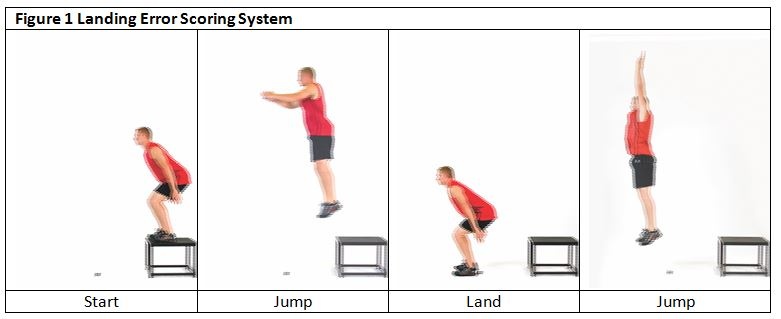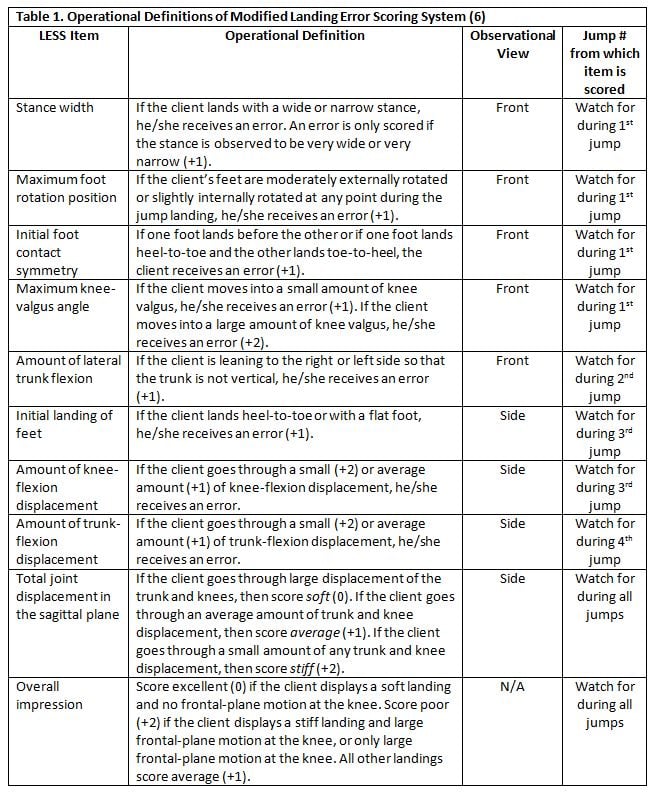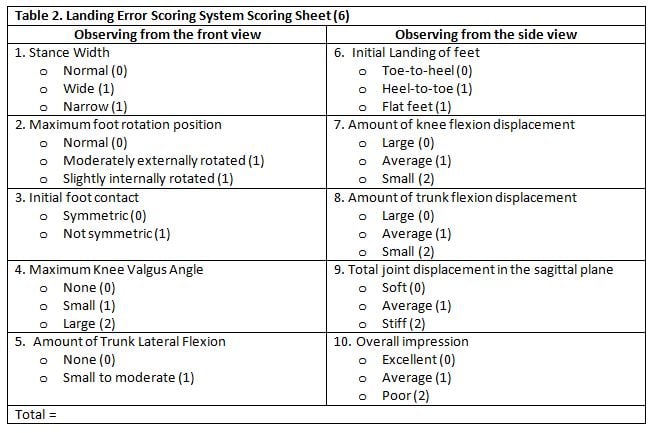It is estimated nearly 150,000 anterior cruciate ligament (ACL) injuries occur annually in the U.S. and approximately 70% of these are noncontact; oftentimes caused by the inability to decelerate, change direction, or land properly from a jump (1,2). Fortunately, research suggests that enhancing joint stability, joint mobility, and neuromuscular coordination through the use of corrective exercise training may alleviate the high incidence of ACL injuries (3-5). However, before designing a corrective exercise program (or a sports performance enhancement program) it is vital to properly assess your client’s movement patterns, as faulty movement patterns are implicated as a risk factor for noncontact ACL injury.
The purpose of this article is to discuss the validity and usability of the Landing Error Scoring System (LESS). The LESS is a movement screen used to identify specific movement patterns of the lower extremities that may increase an individual’s risk for noncontact ACL injury (6).
What is The Landing Error Scoring System (Less Test)?
Every fitness professional should have an arsenal of movement screens at their disposal to adequately assess their client’s movement quality and identify potential muscle imbalances. According to Padua et al., “The Landing Error Scoring System (LESS) is a reliable and valid clinical assessment tool that was developed to identify individuals at risk for lower extremity injuries.”
By identifying faulty movement patterns through the use of the LESS, we can successfully determine if an individual is at increased risk of injury and subsequently design a corrective exercise strategy to address these faulty movements. It can also evaluate changes and improvement in landing technique resulting from a corrective exercise program (7).
However, limitations of this test include a complicated scoring system (17 jump-landing characteristics) and it requires the use of video cameras to record the client’s movement patterns. These requirements make it very difficult for fitness professionals to include this test in an overall assessment process. As such, here we’ll discuss a modified version of the LESS developed by Padua et al. (6) that can be performed in real time by the fitness professional and successfully implemented within a gym or athletic setting within 2-5 minutes.
How to Perform the Modified LESS Test
Position
- The client stands on a 12-inch (30 cm) box. A target line is drawn on the floor at a distance of half the individual’s height.
Movement
- The client is instructed to jump forward from the box and land just ahead of the marked line with both feet landing simultaneously and immediately rebound by jumping for maximum vertical height. The client should not pause between landing on the ground and initiating the vertical jump (Figure 1).
- The client views a demonstration performed by the fitness professional and then gets the opportunity to practice (typically 2-3 times is sufficient).
- The client does not receive any instruction on proper landing mechanics from the fitness professional.
- The client will perform four trials while the fitness professional observes from the front and side.
- During trials 1 and 2 the fitness professional will observe from the front.
- During trials 3 and 4 the fitness professional will observe from the side.
- Table 1 describes operational definitions and scoring details for each item.
- The fitness professional will view both lower extremities. If one lower extremity displays an error (i.e., foot externally rotates) and the other lower extremity does not, the fitness professional still scores the specific item as an error.
- A final score is determined by summing all items. Norms for this assessment do not currently exist. Instead, serial testing will help determine improvement in an individual’s movement quality.
Below is an example scoring sheet (Table 2) fitness professionals can use when implementing the Modified LESS into their overall assessment process.
Precautions
The LESS may not be appropriate for all populations. This is one reason why transitional movement assessments (i.e., Overhead Squat Assessment) are important to perform prior to dynamic assessments. If an individual has difficulty or experiences pain performing transitional movement assessments, then the Modified LESS should be discouraged.
Summary
ACL injuries are overwhelmingly (70%) noncontact in nature and almost always occur as the body undergoes rapid deceleration. Specific movement patterns commonly occurring during ACL and lower extremity injury include knee valgus (knock knee), excessive leg rotation, and decreased knee flexion (i.e., stiff-legged landing) (2,7,8).The use of the Modified LESS examines all of these factors in systematic and easy to use format and can be successfully implemented by fitness professionals in their overall assessment process. Using this information, fitness professionals can then implement a corrective strategy to correct these movement impairments. To learn more about corrective exercise training see NASM’s Essentials of Corrective Exercise Training.
References
1. American Orthopaedic Society for Sports Medicine. Anterior Cruciate Ligament (ACL) Prevention. http://www.sportsmed.org/uploadedFiles/Content/Patient/Sports_Tips/ST%20ACL%20Injury%2008.pdf. Accessed April 8, 2014.
2. Shultz SJ, Schmitz RJ, Benjaminse A, Chaudhari AM, Collins M, Padua DA. ACL Research Retreat VI: an update on ACL injury risk and prevention. J Athl Train. 2012 Sep-Oct;47(5):591-603. doi: 10.4085/1062-6050-47.5.13
3. Padua DA, Bell DR, Clark MA. Neuromuscular characteristics of individuals displaying excessive medial knee displacement. J Athl Train. 2012 Sep-Oct;47(5):525-36. doi: 10.4085/1062-6050-47.5.10.
4. Bell DR, Oates DC, Clark MA, Padua DA. Two- and 3-dimensional knee valgus are reduced after an exercise intervention in young adults with demonstrable valgus during squatting. J Athl Train. 2013 Jul-Aug;48(4):442-9. doi: 10.4085/1062-6050-48.3.16. Epub 2013 May 31.
5. Fong CM, Blackburn JT, Norcross MF, McGrath M, Padua DA. Ankle-dorsiflexion range of motion and landing biomechanics. J Athl Train. 2011 Jan-Feb;46(1):5-10. doi: 10.4085/1062-6050-46.1.5.
6. Padua DA, Boling MC, DiStefano LJ, Onate JA, Beutler AI, Marshall SW. -56. Reliability of the landing error scoring system-real time, a clinical assessment tool of jump-landing biomechanics. J Sport Rehabil. 2011 May;20(2):145-56.
7. DiStefano LJ, Padua DA, DiStefano MJ, Marshall SW. Influence of age, sex, technique, and exercise program on movement patterns after an anterior cruciate ligament injury prevention program in youth soccer players. Am J Sports Med. 2009;37(3):495–505.
8. Shultz SJ, Schmitz RJ, Nguyen AD, Chaudhari AM, Padua DA, McLean SG, Sigward SM. ACL Research Retreat V: an update on ACL injury risk and prevention, March 25-27, 2010, Greensboro, NC. J Athl Train. 2010 Sep-Oct;45(5):499-508. doi: 10.4085/1062-6050-45.5.499.

.jpg)












